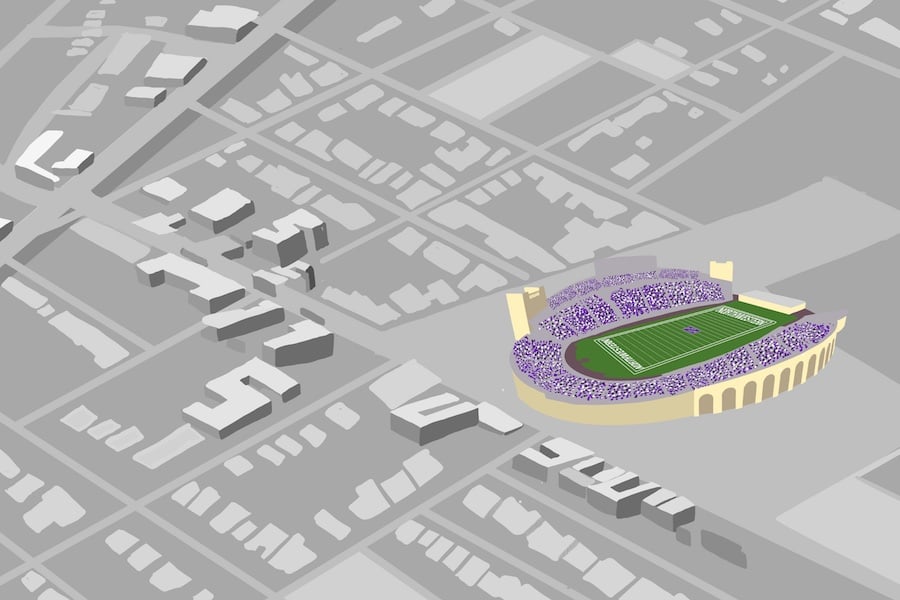Residents and students face a fall season without live sports
November 2, 2020
Most Fall Quarter Saturdays at Northwestern follow a similar pattern. Thousands of students and Evanston residents flock to Ryan Field and the surrounding area for tailgates, parties and — when the Wildcats are playing at home — NU football games. Fans boast purple and white as far as the eye can see, and cheers scatter up to half a mile away. In Evanston, football is king.
This year, however, Ryan Field is quiet.
On Sept. 16, a month before Northwestern’s game-opener against Maryland on Oct. 24, Big Ten Network announced there would be “no public sale of tickets” for football games. Instead, each coach and player is allotted four tickets to invite immediate family members and significant others to the field. The expected attendance for that first Saturday of the season was around a thousand spectators. Ryan Field’s capacity is 49,256.
Northwestern Wildside, the official student section of Northwestern Athletics, typically spends game days leading cheers in the student section at Ryan Field or handing out free NU merchandise outside the venue. This season, its spirit events have gone digital, as Wildside has taken to social media to host contests, hold online meet-ups with coaches and players and host watch parties of old games.
In a typical year, events like football games completely take over the neighborhoods surrounding Ryan Field. Local homeowners host game day parties, and students and fans attend parking lot tailgates. Some weeks, games run late into the night.
However, with limited attendance allowed in the stadium and a University ban on tailgates, Ryan Field’s Saturday atmosphere has completely changed. Ald. Eleanor Revelle (7th) represents the residents who live around Ryan Field in City Council, and said in past years, she would often hear complaints from residents about issues the football games created, like traffic congestion and student overflow.
This year, however, Revelle said she hasn’t heard any complaints.
“The one bit of feedback I did have was from residents on Central Street, just to the south of the stadium, who were very unhappy about the buses that had brought the Maryland team to the stadium,” Revelle said. “They were just sitting there with their motors idling and it’s smelly, it’s noisy, it’s polluting and it’s against the law. So they contacted me about that.”
Many of the other football-related disruptions residents face, however, are nonexistent this year. Evanston resident Ken Proskie lives right next door to Ryan Field, and said often, residents would face extreme traffic delays because of football games. On a typical Saturday, he said what would usually be a five-minute drive could take upwards of 45 minutes. But this year, the congestion doesn’t exist.
Proskie, who attended the University of Michigan, said he’s always enjoyed the energy of football seasons. Though he doesn’t miss game-related disruptions and subsequent cleanups, he said the community feels different this year.
“There’s a lot of things relating to noise, traffic congestion and parking congestion that we really appreciate (being gone),” Proskie said. “Now, it feels more like a residential neighborhood to me. On the other hand, I kind of like the festivities and the stuff that goes on during the football season.”
This season has also changed how publications report on sports. WNUR Sports, Northwestern’s student-run radio sports group, typically would send four staffers to each football game: two broadcasters, a sidelines reporter and someone live-tweeting on press row. However, according to Medill junior and WNUR Sports Director Eric Rynston-Lobel, the broadcasting network is only allowed two broadcasters per game this year.
For Medill senior and WNUR Sports Director Kevin Sweeney, sideline reporting during the 2018 Big Ten West-clinching win against Iowa was “one of the probably top three experiences” of his time at NU. While he recognizes that reporting this season looks different from any fall in the past, he’s still thankful for the opportunity to report at all.
“I think we haven’t come at it from the perspective of, ‘Here’s what we can’t do,’” Sweeney said. “It’s more been like, ‘Here’s what we get to do’ — and be thankful for all that we’re able to do. Because there are a lot of places that don’t have the same opportunities that we do. And we saw our season flash before our eyes. So if it’s one game that I get to be at, it’s one game I get to be at, and I’ll take it.”
Email: fulton@u.northwestern.edu and gracechang2023.1@u.northwestern.edu
Twitter: @jacobnfulton
Related Stories:
— Wildside looks toward fall sports season without fans
— The Longest Offseason A Timeline of Northwestern Football’s 2019-2020 offseason
— Football: Northwestern upsets Iowa after falling behind by 17 points



